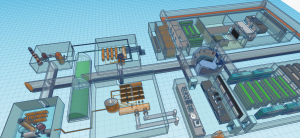Registrations are closed
In the future, to enable astronauts to stay on the Moon for long periods of time, new infrastructures must be developed to overcome important challenges. Such challenges include protection from radiation and meteorites, energy production, the extraction and recycling of water, food production and much more. The Moon Camp Challenge invites students to explore the Moon and decode some of the complexities future astronauts may face.
In Moon Camp Discovery each team’s mission is to 3D design only one component of a Moon Camp using Tinkercad. Teams can choose to design a:
– Lunar lander
– Moon Base
– Lunar rover
– Rocket
– Lunar Orbital Space Station
The design should be adapted to the Moon environment and if possible consider the use of local resources, provide protection and/or living and working facilities for the astronauts.
Moon Camp Discovery is a non-competitive mission for beginners. All teams that submit an entry that complies with the guidelines will receive a participation certificate and their project will be shared on the Moon Camp online platform.
Who can participate?
Participation is open worldwide to students aged up to 19 years old. Moon Camp Discovery is recommended for students aged 6 to 14 years old. Participating students must be supported by a teacher, educator or parent.
Discovery Projects Gallery 2020-2021
Below you can find some of the Moon Camp Discovery projects. For more projects visit the Moon Camp Discovery project gallery.
Team: AMY 5BA
Bruxelles Belgium Category: Moon base
External link for Tinkercad 3D design
The lunar camp is divided into two parts, one dealing with the supply of water, oxygen, electricity and heating, and the other constituting the main building divided itself into two compartments: On the one hand, the first building on the left is composed of the laboratory and decontamination showers, then one finds a reserve of laboratory’s equipment, then a cultivation area cultivating terrestrial and aquatic plants, then a larger reserve storing other equipment, or replacement parts for the installations, and a control post. The building on the right composed by a dormitory for five people and a bathroom and separate toilet.
Thereafter, we find a living room compartmentalized in two sub-rooms, one to maintain its physical condition because of the low gravity leading to the loss of bone and muscle mass and the other, to relax. Beside this living room, we find a spacious room with a large table that can be both a place of work or a dining room equipped with a kitchen. the building ends with a reserve of supplementary equipment.
Then, we find the infirmary built further back in case of contamination or illness, located at the conjunction of the emergency exits marked by an orange platform in the emergency exit tunnels, one to the right and one to the left of the buildings. The base is located between these two buildings and represented by a hexagonal structure. On the other hand, there are the power stations dealing with resource supply. First, starting from the main buildings, there is on the left the oxygen central in front of the laboratory room and connected to the electric central to make pass the current in the process of electrolysis of the regolith to collect the oxygen coming out, in front of this central, the hydraulic central is located and linked to the thermal one allowing to have a hot water supply. Then around the whole lunar camp there are Rawlemons, to concentrate the solar energy necessary for the production of electrical and thermal energy.
















